Quantifying the Spatiotemporal Changes in Evapotranspiration and Its Components Driven by Vegetation Greening and Climate Change in the Northern Foot of Yinshan Mountain
Abstract
1. Introduction
2. Materials and Methods
2.1. Study Area
2.2. Data Sources and Processing
2.3. Methods
2.3.1. Theil–Sen Estimate
2.3.2. Mann–Kendall Test
2.3.3. Partial Correlation
2.3.4. Multiple Regression and Contribution Analysis
2.3.5. Path Analytic Method
3. Results
3.1. Spatiotemporal Variations in E and its Components
3.1.1. Temporal Patterns
3.1.2. Spatial Patterns
3.2. Changes in LAI and Climatic Variables
3.2.1. Temporal Variability
3.2.2. Spatial Variability
3.3. Changes in E, Et, and Eb Caused by Vegetation Greening and Climate Change
4. Discussion
4.1. Spatiotemporal Variation in E, Et, and Eb
4.2. Responses of E, Et, and Eb to Vegetation Greening and Climate Change
4.3. Implications for Vegetation Restoration and Water Resources Management
4.4. Uncertainties
5. Conclusions
- (1)
- In time, E (2.47 mm/a, p < 0.01), Et (1.30 mm/a, p < 0.01), and Eb (1.06 mm/a, p < 0.01) all exhibited a significant upward trend. Spatially, the annual mean E decreased from the east (322.28 mm) to the west (68.59 mm), Et increased from the southeast (0.87 mm) to the northwest (236.55 mm), and Eb decreased from the northeast (205.32 mm) to the southwest (66.11 mm).
- (2)
- Vegetation greening emerges as the predominant impetus underpinning the augmentation of both E and Eb, augmenting their rates by 0.49 mm/a and 0.57 mm/a, respectively. For meteorological variables, Pre exerts the most conspicuous influence upon E (0.46 mm/a). Meanwhile, Temp emerges as the paramount determinant affecting Eb (−0.78 mm/a). Within the realm of Et, meteorological factors emerge as the primary catalysts, with Temp assuming a predominant role by augmenting Et at a rate of 0.35 mm/a. The contribution stemming from vegetation greening to Et is quantified at 0.32 mm/a. In addition, Pre always acts indirectly on E, Et, and Eb through its influence on other factors. Within E, Temp dominated in an area covering 32.75% of the study region. For Et, Temp had the highest dominance, covering 33.83% of the study area. For Eb, the main controlling factors were LAI (32.10%) and Temp (29.50%).
- (3)
- LAI often acted as an intermediary variable between RH, WS, and Pre on E and its components. LAI had a direct path coefficient on Et of 0.22 (p < 0.05). In addition to the direct effect of Pre on E (0.75, p < 0.01) and Et (0.51, p < 0.01), it also had an indirect effect (0.20, p < 0.05 and 0.39, p < 0.01, respectively). The indirect effect of Temp on Eb was more significant (−0.13, p < 0.05), while Rad mainly had a direct effect on Eb (−0.21, p < 0.05).
Author Contributions
Funding
Data Availability Statement
Acknowledgments
Conflicts of Interest
Appendix A

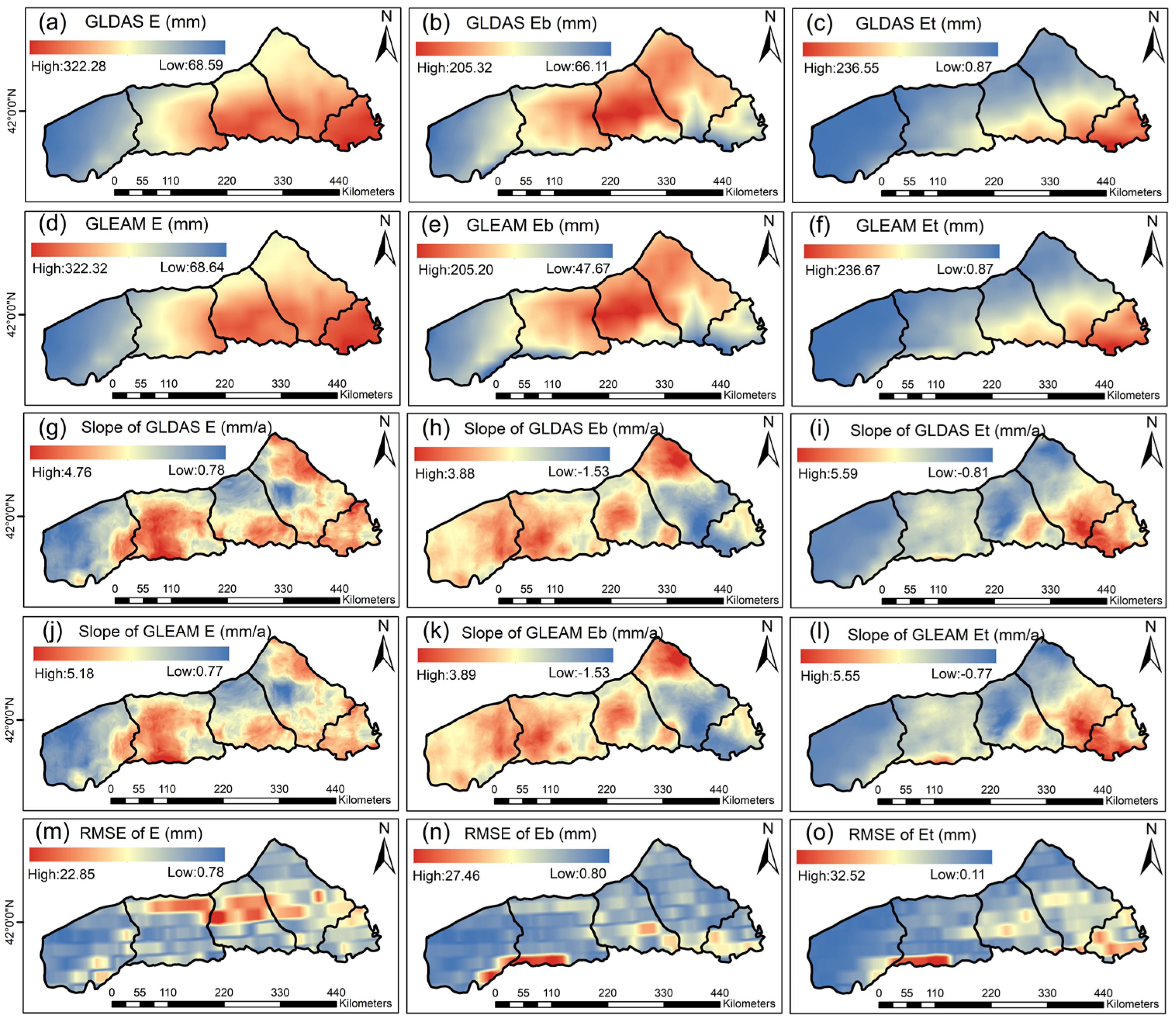
References
- Zhang, K.; Kimball, J.S.; Running, S.W. A review of remote sensing based actual evapotranspiration estimation. Wiley Interdiscip. Rev. Water 2016, 3, 834–853. [Google Scholar] [CrossRef]
- L’Ecuyer, T.S.; Beaudoing, H.K.; Rodell, M.; Olson, W.; Lin, B.; Kato, S.; Clayson, C.A.; Wood, E.; Sheffield, J.; Adler, R.; et al. The Observed State of the Energy Budget in the Early Twenty-First Century. J. Clim. 2015, 28, 8319–8346. [Google Scholar] [CrossRef]
- Trenberth, K.E.; Smith, L.; Qian, T.T.; Dai, A.; Fasullo, J. Estimates of the global water budget and its annual cycle using observational and model data. J. Hydrometeorol. 2007, 8, 758–769. [Google Scholar] [CrossRef]
- Sun, S.L.; Liu, Y.B.; Chen, H.S.; Ju, W.M.; Xu, C.Y.; Liu, Y.; Zhou, B.T.; Zhou, Y.; Zhou, Y.L.; Yu, M. Causes for the increases in both evapotranspiration and water yield over vegetated mainland China during the last two decades. Agric. For. Meteorol. 2022, 324, 109118. [Google Scholar] [CrossRef]
- Niu, Z.G.; He, H.L.; Zhu, G.F.; Ren, X.L.; Zhang, L.; Zhang, K.; Yu, G.R.; Ge, R.; Li, P.; Zeng, N.; et al. An increasing trend in the ratio of transpiration to total terrestrial evapotranspiration in China from 1982 to 2015 caused by greening and warming. Agric. For. Meteorol. 2019, 279, 107701. [Google Scholar] [CrossRef]
- Elbeltagi, A.; Kumari, N.; Dharpure, J.K.; Mokhtar, A.; Alsafadi, K.; Kumar, M.; Mehdinejadiani, B.; Etedali, H.R.; Brouziyne, Y.; Islam, A.M.T.; et al. Prediction of Combined Terrestrial Evapotranspiration Index (CTEI) over Large River Basin Based on Machine Learning Approaches. Water 2021, 13, 547. [Google Scholar] [CrossRef]
- Fisher, J.B.; Melton, F.; Middleton, E.; Hain, C.; Anderson, M.; Allen, R.; McCabe, M.F.; Hook, S.; Baldocchi, D.; Townsend, P.A.; et al. The future of evapotranspiration: Global requirements for ecosystem functioning, carbon and climate feedbacks, agricultural management, and water resources. Water Resour. Res. 2017, 53, 2618–2626. [Google Scholar] [CrossRef]
- Lee, S.J.; Kim, N.; Lee, Y. Development of Integrated Crop Drought Index by Combining Rainfall, Land Surface Temperature, Evapotranspiration, Soil Moisture, and Vegetation Index for Agricultural Drought Monitoring. Remote Sens. 2021, 13, 1778. [Google Scholar] [CrossRef]
- Cheng, L.Z.; Yang, M.X.; Wang, X.J.; Wan, G.N. Spatial and Temporal Variations of Terrestrial Evapotranspiration in the Upper Taohe River Basin from 2001 to 2018 Based on MOD16 ET Data. Adv. Meteorol. 2020, 2020, 3721414. [Google Scholar] [CrossRef]
- Cheng, M.H.; Jiao, X.Y.; Jin, X.L.; Li, B.B.; Liu, K.H.; Shi, L. Satellite time series data reveal interannual and seasonal spatiotemporal evapotranspiration patterns in China in response to effect factors. Agric. Water Manag. 2021, 255, 107046. [Google Scholar] [CrossRef]
- Pascolini-Campbell, M.; Reager, J.T.; Chandanpurkar, H.A.; Rodell, M. A 10 percent increase in global land evapotranspiration from 2003 to 2019. Nature 2021, 593, 543–547. [Google Scholar] [CrossRef] [PubMed]
- Baldocchi, D.; Falge, E.; Gu, L.H.; Olson, R.; Hollinger, D.; Running, S.; Anthoni, P.; Bernhofer, C.; Davis, K.; Evans, R.; et al. FLUXNET: A new tool to study the temporal and spatial variability of ecosystem-scale carbon dioxide, water vapor, and energy flux densities. Bull. Am. Meteorol. Soc. 2001, 82, 2415–2434. [Google Scholar] [CrossRef]
- Jung, M.; Koirala, S.; Weber, U.; Ichii, K.; Gans, F.; Camps-Valls, G.; Papale, D.; Schwalm, C.; Tramontana, G.; Reichstein, M. The FLUXCOM ensemble of global land-atmosphere energy fluxes. Sci. Data 2019, 6, 74. [Google Scholar] [CrossRef] [PubMed]
- Chen, H.; Huang, J.H.J.; McBean, E.; Singh, V.P. Evaluation of alternative two-source remote sensing models in partitioning of land evapotranspiration. J. Hydrol. 2021, 597, 126029. [Google Scholar] [CrossRef]
- Cui, Y.K.; Song, L.S.; Fan, W.J. Generation of spatio-temporally continuous evapotranspiration and its components by coupling a two-source energy balance model and a deep neural network over the Heihe River Basin. J. Hydrol. 2021, 597, 126176. [Google Scholar] [CrossRef]
- Yang, Y.; Guan, K.Y.; Peng, B.; Pan, M.; Jiang, C.Y.; Franz, T.E. High-resolution spatially explicit land surface model calibration using field-scale satellite-based daily evapotranspiration product. J. Hydrol. 2021, 596, 125730. [Google Scholar] [CrossRef]
- Mu, Q.; Heinsch, F.A.; Zhao, M.; Running, S.W. Development of a global evapotranspiration algorithm based on MODIS and global meteorology data. Remote Sens. Environ. 2007, 111, 519–536. [Google Scholar] [CrossRef]
- Mu, Q.Z.; Zhao, M.S.; Running, S.W. Improvements to a MODIS global terrestrial evapotranspiration algorithm. Remote Sens. Environ. 2011, 115, 1781–1800. [Google Scholar] [CrossRef]
- Yang, X.Q.; Yong, B.; Ren, L.L.; Zhang, Y.Q.; Long, D. Multi-scale validation of GLEAM evapotranspiration products over China via ChinaFLUX ET measurements. Int. J. Remote Sens. 2017, 38, 5688–5709. [Google Scholar] [CrossRef]
- Baik, J.; Choi, M. Multi-satellite-based water budget components in South Korea. Environ. Earth Sci. 2018, 77, 93. [Google Scholar] [CrossRef]
- Feng, Y.; Cui, N.B.; Zhao, L.; Gong, D.Z.; Zhang, K.D. Spatiotemporal variation of reference evapotranspiration during 1954–2013 in Southwest China. Quat. Int. 2017, 441, 129–139. [Google Scholar] [CrossRef]
- Zhang, S.L.; Yang, H.B.; Yang, D.W.; Jayawardena, A.W. Quantifying the effect of vegetation change on the regional water balance within the Budyko framework. Geophys. Res. Lett. 2016, 43, 1140–1148. [Google Scholar] [CrossRef]
- Schlaepfer, D.R.; Ewers, B.E.; Shuman, B.N.; Williams, D.G.; Frank, J.M.; Massman, W.J.; Lauenroth, W.K. Terrestrial water fluxes dominated by transpiration: Comment. Ecosphere 2014, 5, 1–9. [Google Scholar] [CrossRef]
- Lian, X.; Piao, S.L.; Huntingford, C.; Li, Y.; Zeng, Z.Z.; Wang, X.H.; Ciais, P.; McVicar, T.R.; Peng, S.S.; Ottle, C.; et al. Partitioning global land evapotranspiration using CMIP5 models constrained by observations. Nat. Clim. Chang. 2018, 8, 640–646. [Google Scholar] [CrossRef]
- Porada, P.; Van Stan, J.T.; Kleidon, A. Significant contribution of non-vascular vegetation to global rainfall interception. Nat. Geosci. 2018, 11, 563–567. [Google Scholar] [CrossRef]
- Zhang, Y.Q.; Pena-Arancibia, J.L.; McVicar, T.R.; Chiew, F.H.S.; Vaze, J.; Liu, C.M.; Lu, X.J.; Zheng, H.X.; Wang, Y.P.; Liu, Y.Y.; et al. Multi-decadal trends in global terrestrial evapotranspiration and its components. Sci. Rep. 2016, 6, 19124. [Google Scholar] [CrossRef] [PubMed]
- Costa, M.H.; Biajoli, M.C.; Sanches, L.; Malhado, A.C.M.; Hutyra, L.R.; da Rocha, H.R.; Aguiar, R.G.; de Araujo, A.C. Atmospheric versus vegetation controls of Amazonian tropical rain forest evapotranspiration: Are the wet and seasonally dry rain forests any different? J. Geophys. Res. Biogeosci. 2010, 115, G04021. [Google Scholar] [CrossRef]
- Kukal, M.; Irmak, S. Long-term patterns of air temperatures, daily temperature range, precipitation, grass-reference evapotranspiration and aridity index in the USA great plains: Part II. Temporal trends. J. Hydrol. 2016, 542, 978–1001. [Google Scholar] [CrossRef]
- Adeyeri, O.E.; Ishola, K.A. Variability and Trends of Actual Evapotranspiration over West Africa: The Role of Environmental Drivers. Agric. For. Meteorol. 2021, 308, 108574. [Google Scholar] [CrossRef]
- Skliris, N.; Zika, J.D.; Nurser, G.; Josey, S.A.; Marsh, R. Global water cycle amplifying at less than the Clausius-Clapeyron rate. Sci. Rep. 2016, 6, 38752. [Google Scholar] [CrossRef]
- Trebs, I.; Mallick, K.; Bhattarai, N.; Sulis, M.; Cleverly, J.; Woodgate, W.; Silberstein, R.; Hinko-Najera, N.; Beringer, J.; Meyer, W.S.; et al. The role of aerodynamic resistance in thermal remote sensing-based evapotranspiration models. Remote Sens. Environ. 2021, 264, 112602. [Google Scholar] [CrossRef]
- Duo, A.; Zhao, W.J.; Qua, X.Y.; Jing, R.; Xiong, K. Spatio-temporal variation of vegetation coverage and its response to climate change in North China plain in the last 33 years. Int. J. Appl. Earth Obs. Geoinformat. 2016, 53, 103–117. [Google Scholar] [CrossRef]
- Sun, G.; Caldwell, P.V.; McNulty, S.G. Modelling the potential role of forest thinning in maintaining water supplies under a changing climate across the conterminous United States. Hydrol. Process. 2015, 29, 5016–5030. [Google Scholar] [CrossRef]
- Jin, Z.; Liang, W.; Yang, Y.T.; Zhang, W.B.; Yan, J.W.; Chen, X.J.; Li, S.; Mo, X.G. Separating Vegetation Greening and Climate Change Controls on Evapotranspiration trend over the Loess Plateau. Sci. Rep. 2017, 7, 8191. [Google Scholar] [CrossRef] [PubMed]
- Mo, X.G.; Chen, X.J.; Hu, S.; Liu, S.X.; Xia, J. Attributing regional trends of evapotranspiration and gross primary productivity with remote sensing: A case study in the North China Plain. Hydrol. Earth Syst. Sci. 2017, 21, 295–310. [Google Scholar] [CrossRef]
- Zhao, F.B.; Ma, S.; Wu, Y.P.; Qiu, L.J.; Wang, W.K.; Lian, Y.Q.; Chen, J.; Sivakumar, B. The role of climate change and vegetation greening on evapotranspiration variation in the Yellow River Basin, China. Agric. For. Meteorol. 2022, 316, 108842. [Google Scholar] [CrossRef]
- Deng, C.L.; Zhang, B.Q.; Cheng, L.Y.; Hu, L.Q.; Chen, F.H. Vegetation dynamics and their effects on surface water-energy balance over the Three-North Region of China. Agric. For. Meteorol. 2019, 275, 79–90. [Google Scholar] [CrossRef]
- Xue, Y.; Liang, H.; Zhang, H.; Yin, L.; Feng, X. Quantifying the policy-driven large scale vegetation restoration effects on evapotranspiration over drylands in China. J. Environ. Manag. 2023, 345, 118723. [Google Scholar] [CrossRef]
- Zhang, Y.Q.; Kong, D.D.; Gan, R.; Chiew, F.H.S.; McVicar, T.R.; Zhang, Q.; Yang, Y.T. Coupled estimation of 500 m and 8-day resolution global evapotranspiration and gross primary production in 2002–2017. Remote Sens. Environ. 2019, 222, 165–182. [Google Scholar] [CrossRef]
- Khan, M.S.; Liaqat, U.W.; Baik, J.; Choi, M. Stand-alone uncertainty characterization of GLEAM, GLDAS and MOD16 evapotranspiration products using an extended triple collocation approach. Agric. For. Meteorol. 2018, 252, 256–268. [Google Scholar] [CrossRef]
- Wang, W.; Cui, W.; Wang, X.J.; Chen, X. Evaluation of GLDAS-1 and GLDAS-2 Forcing Data and Noah Model Simulations over China at the Monthly Scale. J. Hydrometeorol. 2016, 17, 2815–2833. [Google Scholar] [CrossRef]
- Liu, Y.Y.; Lin, Z.Q.; Wang, Z.J.; Chen, X.; Han, P.D.; Wang, B.; Wang, Z.Q.; Wen, Z.M.; Shi, H.J.; Zhang, Z.X.; et al. Discriminating the impacts of vegetation greening and climate change on the changes in evapotranspiration and transpiration fraction over the Yellow River Basin. Sci. Total Environ. 2023, 904, 166926. [Google Scholar] [CrossRef] [PubMed]
- Wang, L.X.; Good, S.P.; Caylor, K.K. Global synthesis of vegetation control on evapotranspiration partitioning. Geophys. Res. Lett. 2014, 41, 6753–6757. [Google Scholar] [CrossRef]
- Zeng, Z.Z.; Piao, S.L.; Li, L.Z.X.; Zhou, L.M.; Ciais, P.; Wang, T.; Li, Y.; Lian, X.; Wood, E.F.; Friedlingstein, P.; et al. Climate mitigation from vegetation biophysical feedbacks during the past three decades. Nat. Clim. Chang. 2017, 7, 432–436. [Google Scholar] [CrossRef]
- Wei, Z.W.; Yoshimura, K.; Wang, L.X.; Miralles, D.G.; Jasechko, S.; Lee, X.H. Revisiting the contribution of transpiration to global terrestrial evapotranspiration. Geophys. Res. Lett. 2017, 44, 2792–2801. [Google Scholar] [CrossRef]
- Yang, J.; Huang, X. The 30 m annual land cover dataset and its dynamics in China from 1990 to 2019. Earth Syst. Sci. Data 2021, 13, 3907–3925. [Google Scholar] [CrossRef]
- Terán, C.P.; Naz, B.S.; Graf, A.; Qu, Y.Q.; Franssen, H.J.H.; Baatz, R.; Ciais, P.; Vereecken, H. Rising water-use efficiency in European grasslands is driven by increased primary production. Commun. Earth Environ. 2023, 4, 95. [Google Scholar] [CrossRef]
- Yang, S.S.; Zhang, J.H.; Han, J.Q.; Wang, J.W.; Zhang, S.; Bai, Y.; Cao, D.; Xun, L.; Zheng, M.X.; Chen, H.; et al. Evaluating global ecosystem water use efficiency response to drought based on multi-model analysis. Sci. Total Environ. 2021, 778, 146356. [Google Scholar] [CrossRef]
- Yang, X.Y.; Zhang, Z.P.; Guan, Q.Y.; Zhang, E.; Sun, Y.F.; Yan, Y.; Du, Q.Q. Coupling mechanism between vegetation and multi-depth soil moisture in arid-semiarid area: Shift of dominant role from vegetation to soil moisture. For. Ecol. Manag. 2023, 546, 121323. [Google Scholar] [CrossRef]
- Zhao, Y.; Chen, Y.A.; Wu, C.Y.; Li, G.; Ma, M.G.; Fan, L.; Zheng, H.; Song, L.S.; Tang, X.G. Exploring the contribution of environmental factors to evapotranspiration dynamics in the Three-River-Source region, China. J. Hydrol. 2023, 626, 130222. [Google Scholar] [CrossRef]
- Chen, X.J.; Mo, X.G.; Hu, S.; Liu, S.X. Contributions of climate change and human activities to ET and GPP trends over North China Plain from 2000 to 2014. J. Geogr. Sci. 2017, 27, 661–680. [Google Scholar] [CrossRef]
- Li, X.Y.; Zou, L.; Xia, J.; Dou, M.; Li, H.W.; Song, Z.H. Untangling the effects of climate change and land use/cover change on spatiotemporal variation of evapotranspiration over China. J. Hydrol. 2022, 612, 128189. [Google Scholar] [CrossRef]
- Roderick, M.L.; Rotstayn, L.D.; Farquhar, G.D.; Hobbins, M.T. On the attribution of changing pan evaporation. Geophys. Res. Lett. 2007, 34, L17403. [Google Scholar] [CrossRef]
- Ye, X.C.; Li, X.H.; Liu, J.; Xu, C.Y.; Zhang, Q. Variation of reference evapotranspiration and its contributing climatic factors in the Poyang Lake catchment, China. Hydrol. Process. 2014, 28, 6151–6162. [Google Scholar] [CrossRef]
- Abel, S.; Gislum, R.; Boelt, B. Path and correlation analysis of perennial ryegrass (Lolium perenne L.) seed yield components. J. Agron. Crop Sci. 2017, 203, 338–344. [Google Scholar] [CrossRef]
- Yu, S.W.; Zhu, K.J.; Zhang, X. Energy demand projection of China using a path-coefficient analysis and PSO-GA approach. Energy Convers. Manag. 2012, 53, 142–153. [Google Scholar] [CrossRef]
- Zhang, B.Z.; Xu, D.; Liu, Y.; Li, F.S.; Cai, J.B.; Du, L.J. Multi-scale evapotranspiration of summer maize and the controlling meteorological factors in north China. Agric. For. Meteorol. 2016, 216, 1–12. [Google Scholar] [CrossRef]
- Ebrahimi, E.; Bayat, H.; Fallah, M. Relationship of soil moisture characteristic curve and mechanical properties in Entisols and Inceptisols of Iran. Geoderma Reg. 2021, 27, e00434. [Google Scholar] [CrossRef]
- Hou, E.Q.; Chen, C.R.; Luo, Y.Q.; Zhou, G.Y.; Kuang, Y.W.; Zhang, Y.G.; Heenan, M.; Lu, X.K.; Wen, D.Z. Effects of climate on soil phosphorus cycle and availability in natural terrestrial ecosystems. Glob. Chang. Biol. 2018, 24, 3344–3356. [Google Scholar] [CrossRef]
- Rosseel, Y. lavaan: An R Package for Structural Equation Modeling. J. Stat. Softw. 2012, 48, 1–36. [Google Scholar] [CrossRef]
- Wang, C.Y.; Chen, J.; Gu, L.; Wu, G.Y.; Tong, S.L.; Xiong, L.H.; Xu, C.Y. A pathway analysis method for quantifying the contributions of precipitation and potential evapotranspiration anomalies to soil moisture drought. J. Hydrol. 2023, 621, 129570. [Google Scholar] [CrossRef]
- Li, D.H.; Liu, K.; Wang, S.D.; Wu, T.X.; Li, H.; Bo, Y.; Zhang, H.Y.; Huang, Y.L.; Li, X.K. Four decades of hydrological response to vegetation dynamics and anthropogenic factors in the Three-North Region of China and Mongolia. Sci. Total Environ. 2023, 857, 159546. [Google Scholar] [CrossRef] [PubMed]
- Cailliau, M.; Foresti, M.; Villar, C.M. Winds of Change. IEEE Power Energy Mag. 2010, 8, 53–62. [Google Scholar] [CrossRef]
- Xu, J.M.; Wu, B.F.; Ryu, D.; Yan, N.N.; Zhu, W.W.; Ma, Z.H. A canopy conductance model with temporal physiological and environmental factors. Sci. Total Environ. 2021, 791, 148283. [Google Scholar] [CrossRef] [PubMed]
- Chattopadhyay, N.; Hulme, M. Evaporation and potential evapotranspiration in India under conditions of recent and future climate change. Agric. For. Meteorol. 1997, 87, 55–73. [Google Scholar] [CrossRef]
- Barnett, T.P.; Adam, J.C.; Lettenmaier, D.P. Potential impacts of a warming climate on water availability in snow-dominated regions. Nature 2005, 438, 303–309. [Google Scholar] [CrossRef]
- Murray-Tortarolo, G.; Friedlingstein, P.; Sitch, S.; Seneviratne, S.I.; Fletcher, I.; Mueller, B.; Greve, P.; Anav, A.; Liu, Y.; Ahlstrom, A.; et al. The dry season intensity as a key driver of NPP trends. Geophys. Res. Lett. 2016, 43, 2632–2639. [Google Scholar] [CrossRef]
- Caldwell, P.V.; Kennen, J.G.; Sun, G.; Kiang, J.E.; Butcher, J.B.; Eddy, M.C.; Hay, L.E.; LaFontaine, J.H.; Hain, E.F.; Nelson, S.A.C.; et al. A comparison of hydrologic models for ecological flows and water availability. Ecohydrology 2015, 8, 1525–1546. [Google Scholar] [CrossRef]
- Cao, S.X.; Chen, L.; Shankman, D.; Wang, C.M.; Wang, X.B.; Zhang, H. Excessive reliance on afforestation in China’s arid and semi-arid regions: Lessons in ecological restoration. Earth-Sci. Rev. 2011, 104, 240–245. [Google Scholar] [CrossRef]
- Tian, F.; Lu, Y.H.; Fu, B.J.; Zhang, L.; Zang, C.F.; Yang, Y.H.; Qiu, G.Y. Challenge of vegetation greening on water resources sustainability: Insights from a modeling-based analysis in Northwest China. Hydrol. Process. 2017, 31, 1469–1478. [Google Scholar] [CrossRef]
- Bai, P.; Liu, X.M.; Zhang, Y.Q.; Liu, C.M. Assessing the Impacts of Vegetation Greenness Change on Evapotranspiration and Water Yield in China. Water Resour. Res. 2020, 56, e2019wr027019. [Google Scholar] [CrossRef]
- Xie, S.D.; Mo, X.G.; Hu, S.; Liu, S.X. Contributions of climate change, elevated atmospheric CO2 and human activities to ET and GPP trends in the Three-North Region of China. Agric. For. Meteorol. 2020, 295, 108183. [Google Scholar] [CrossRef]
- Shen, M.G.; Piao, S.L.; Jeong, S.J.; Zhou, L.M.; Zeng, Z.Z.; Ciais, P.; Chen, D.L.; Huang, M.T.; Jin, C.S.; Li, L.Z.X.; et al. Evaporative cooling over the Tibetan Plateau induced by vegetation growth. Proc. Natl. Acad. Sci. USA 2015, 112, 9299–9304. [Google Scholar] [CrossRef] [PubMed]
- Ge, J.; Liu, Q.; Zan, B.L.; Lin, Z.Q.; Lu, S.; Qiu, B.; Guo, W.D. Deforestation intensifies daily temperature variability in the northern extratropics. Nat. Commun. 2022, 13, 5955. [Google Scholar] [CrossRef]
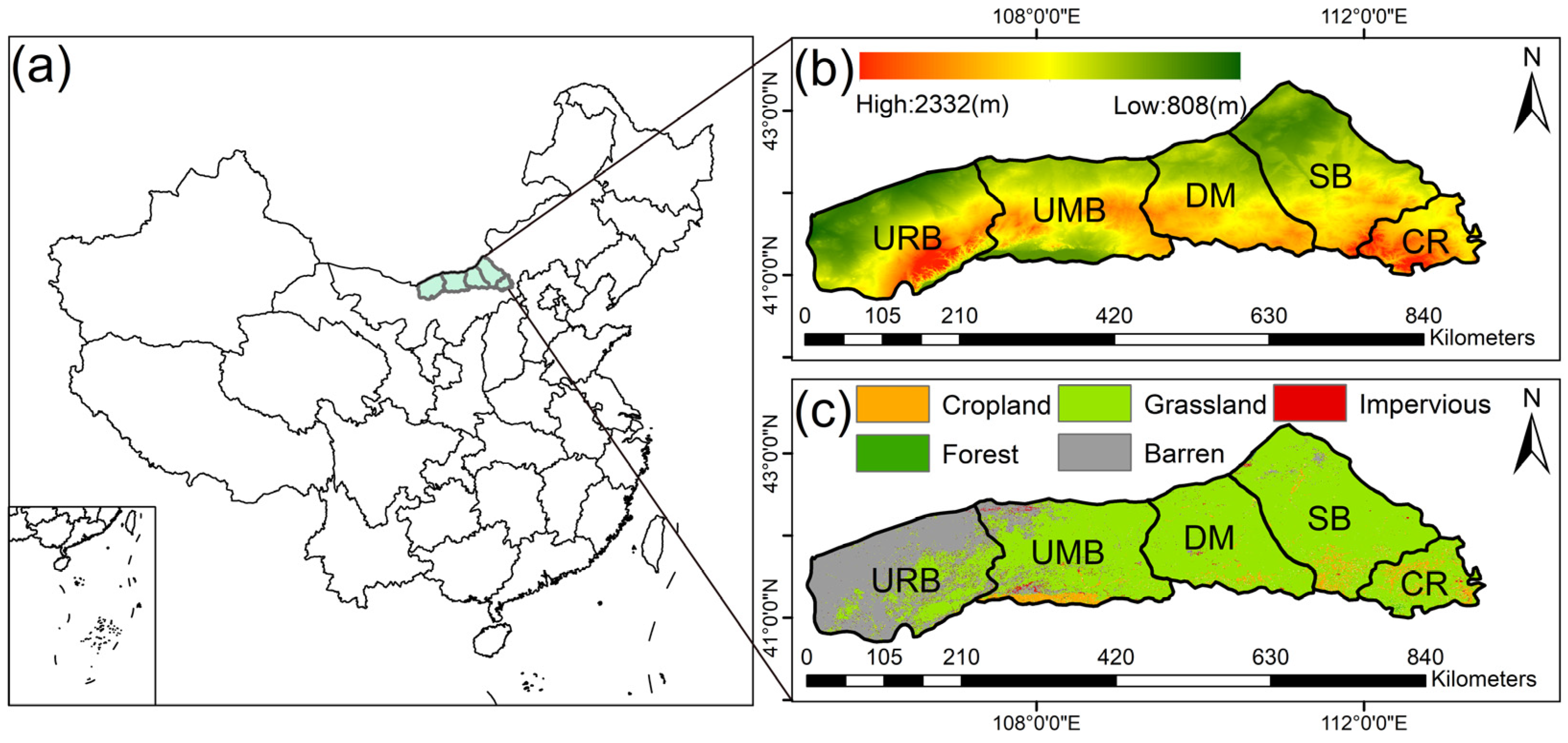

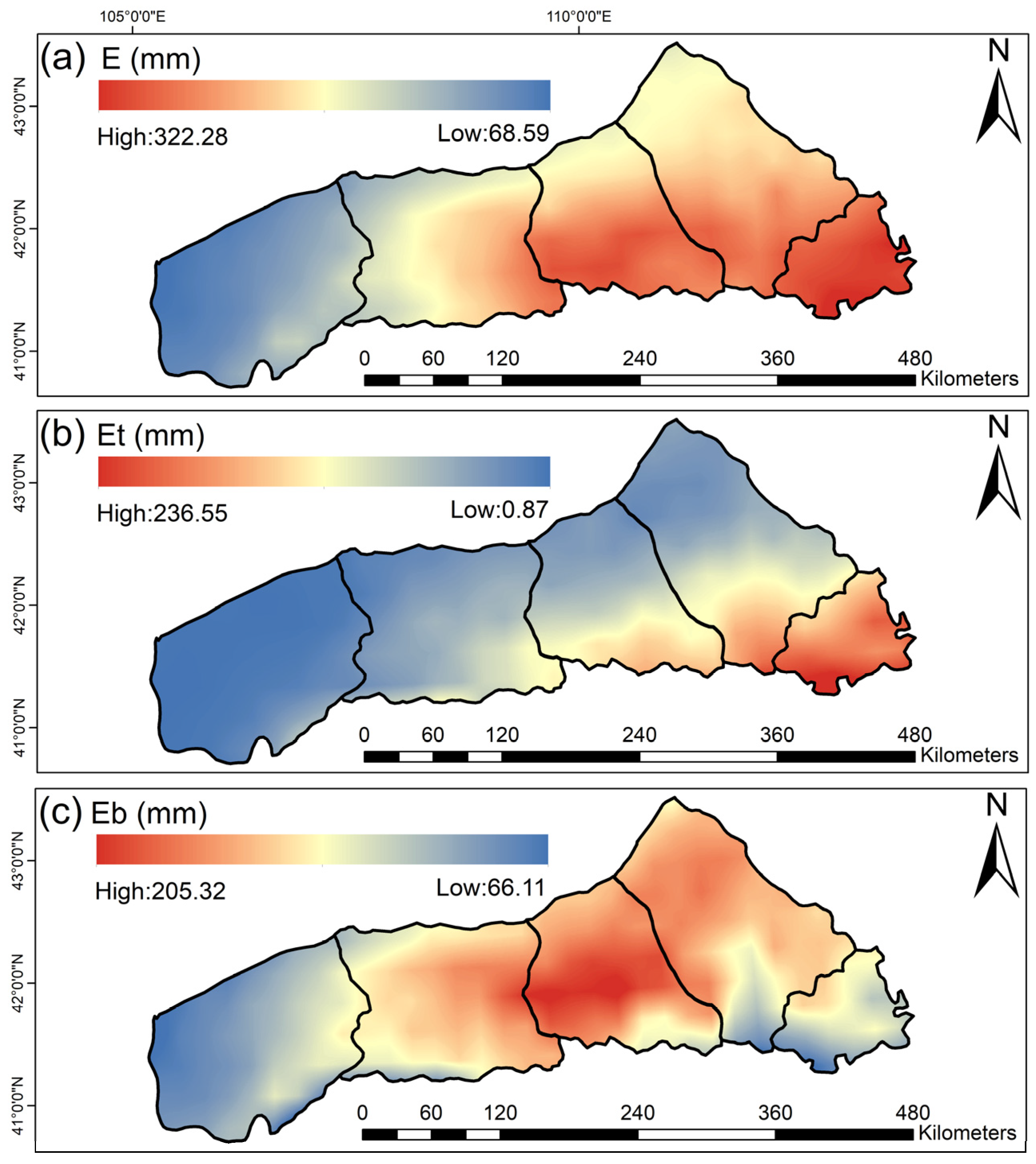


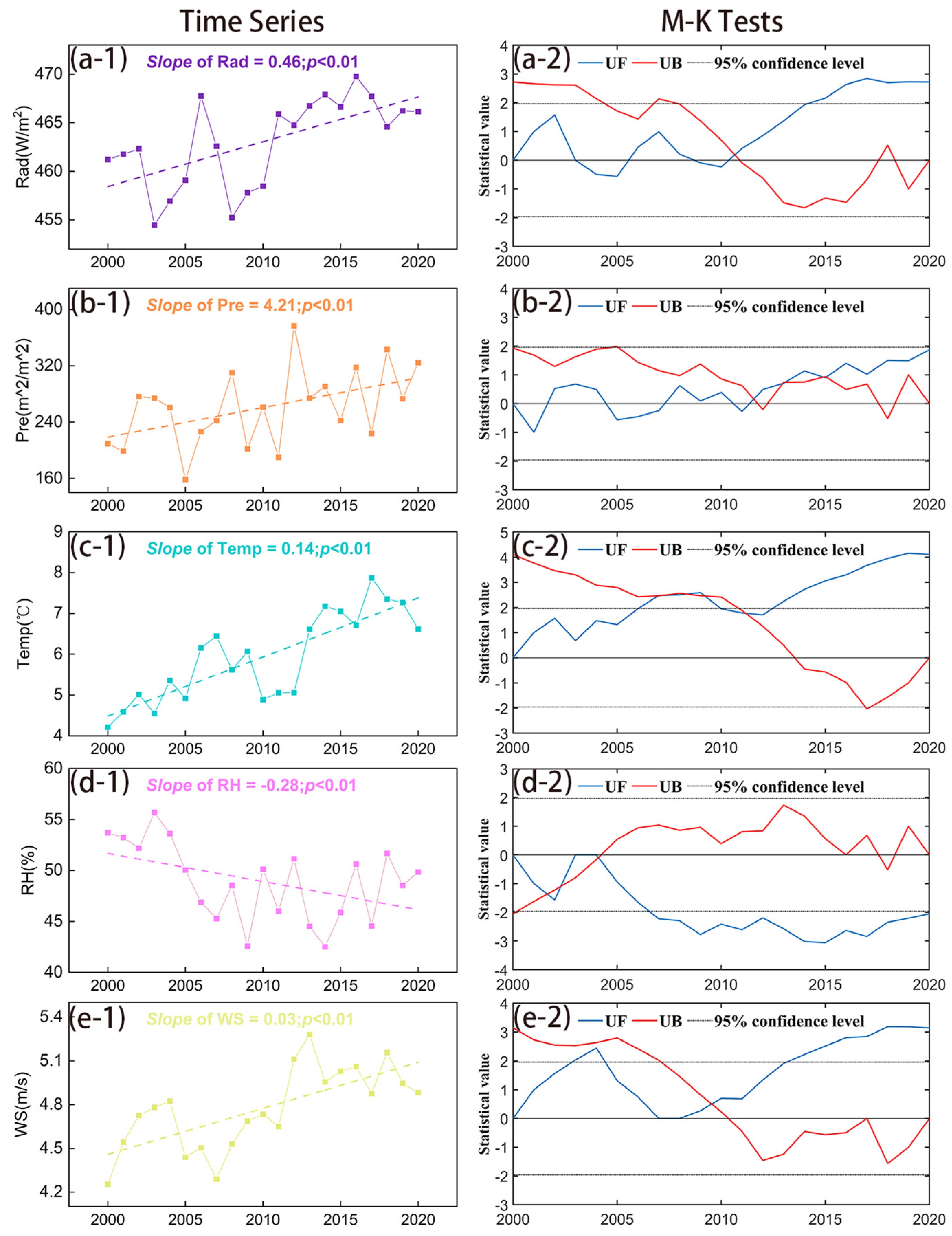
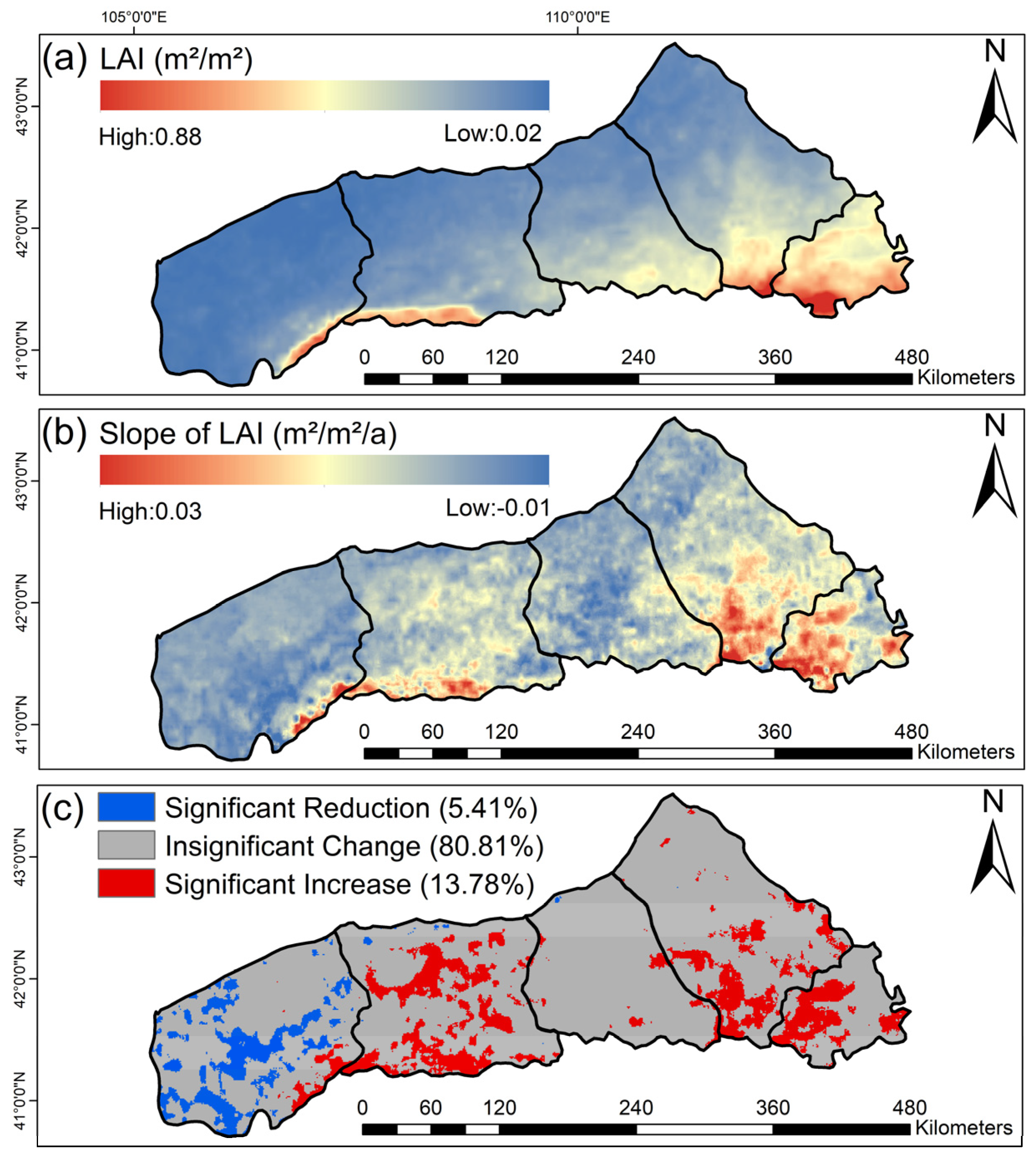
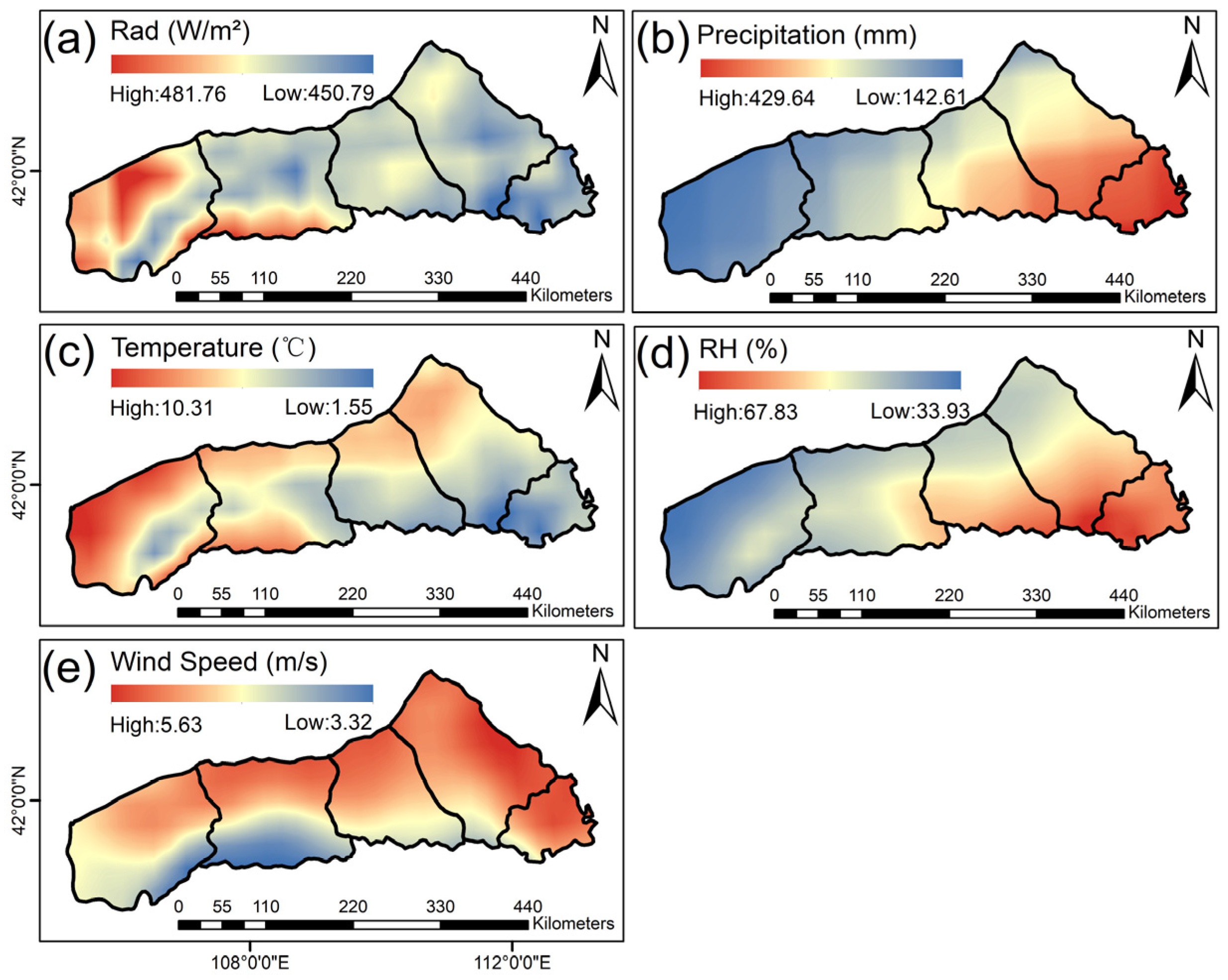
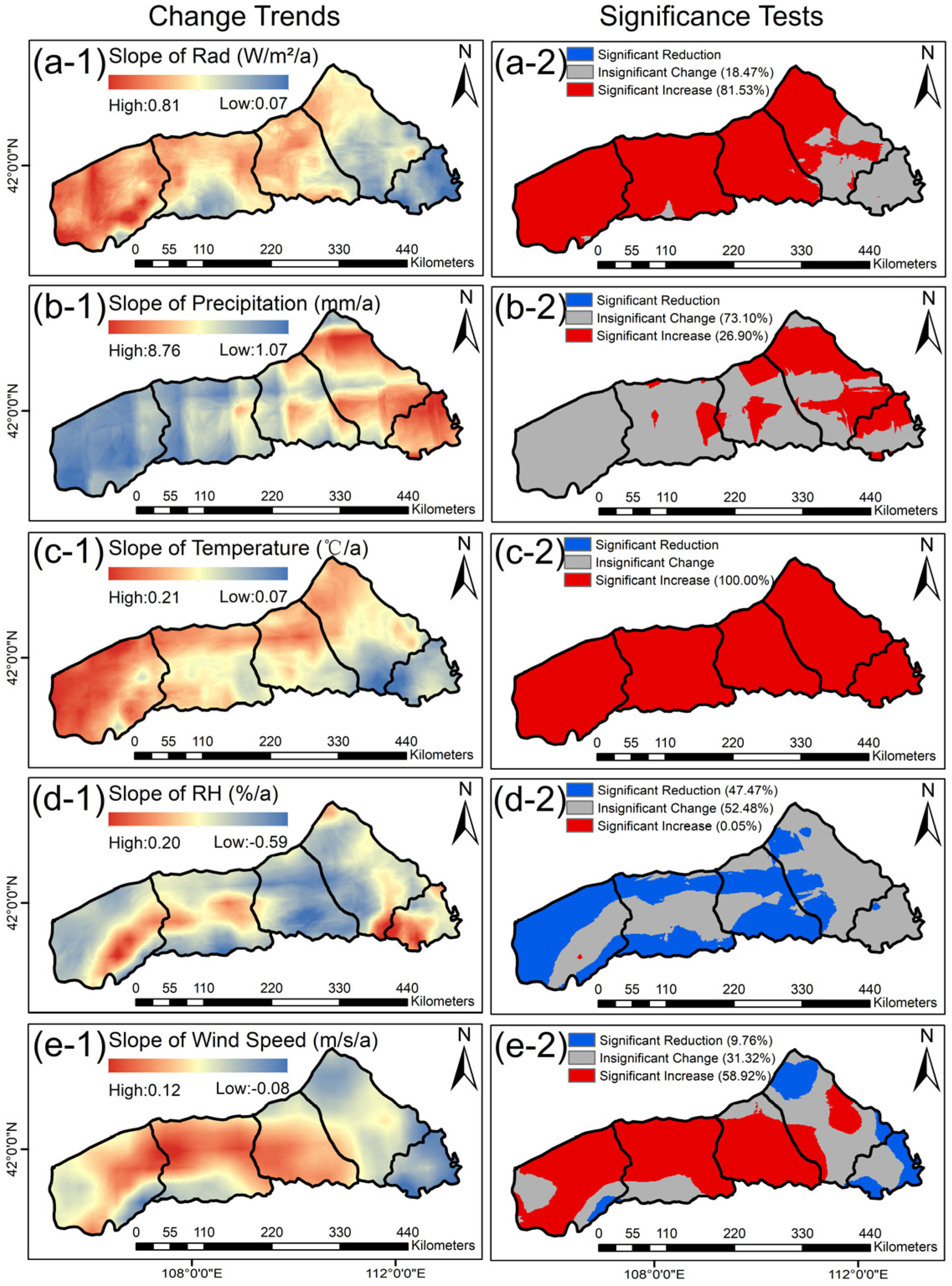
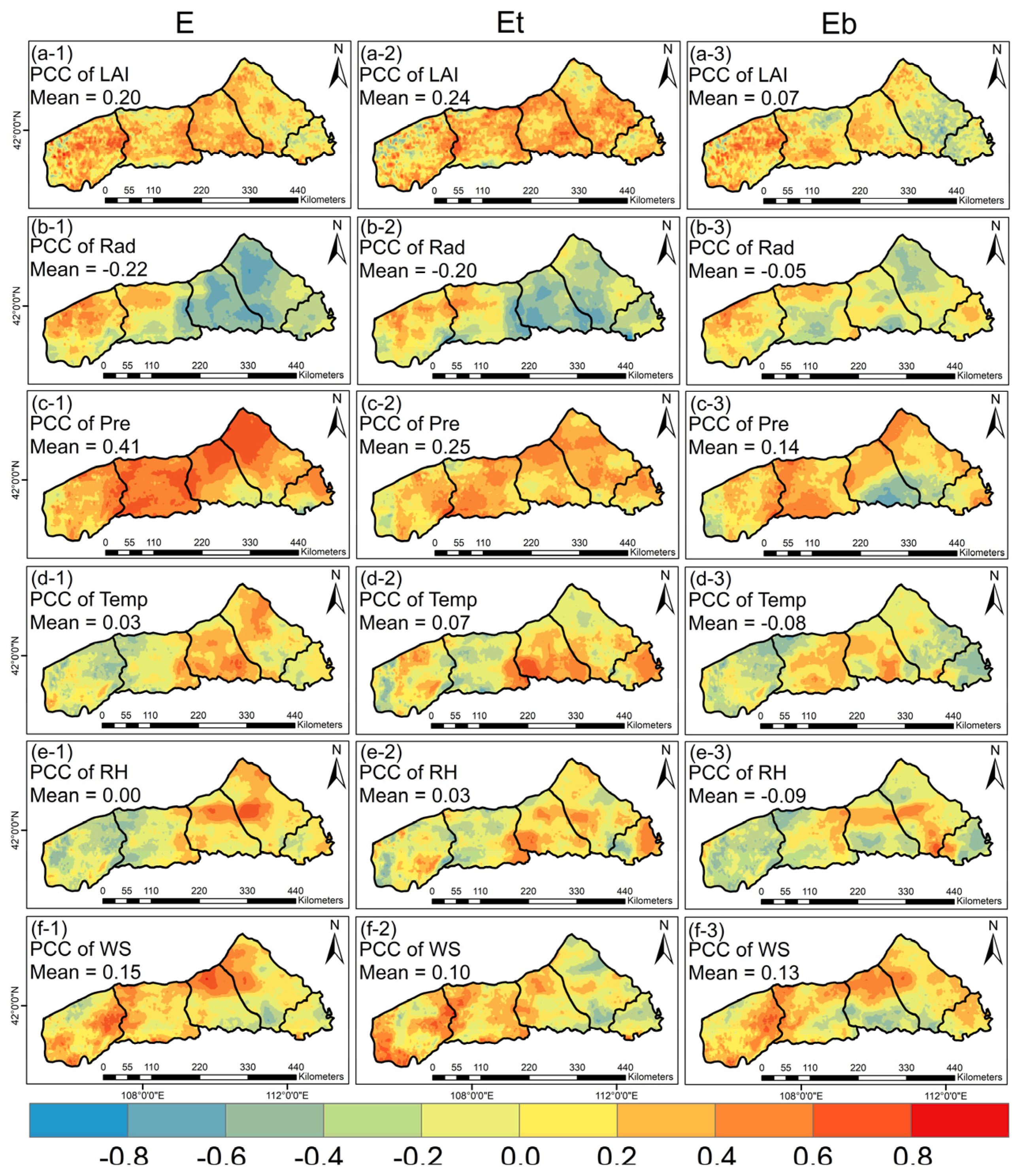
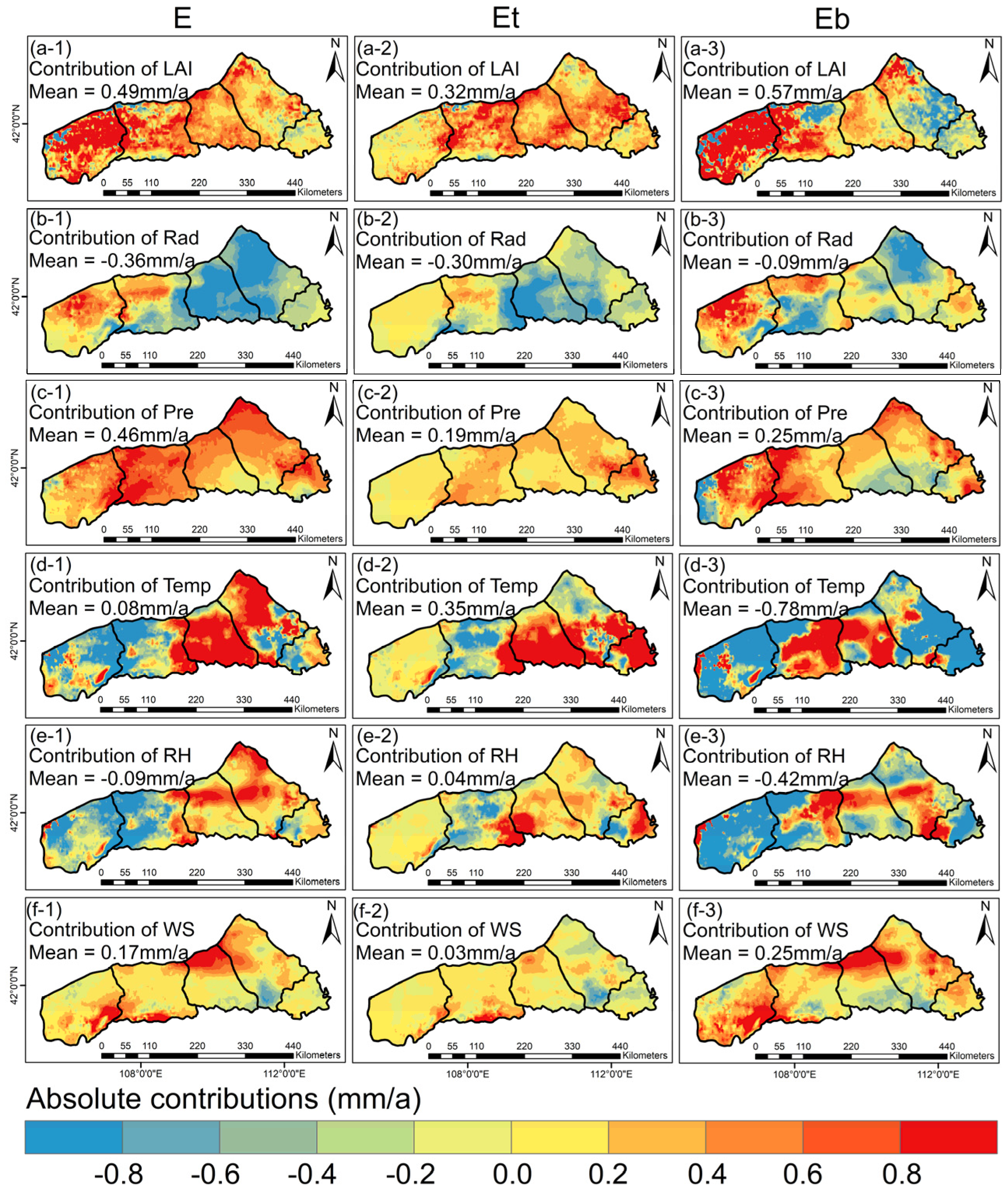
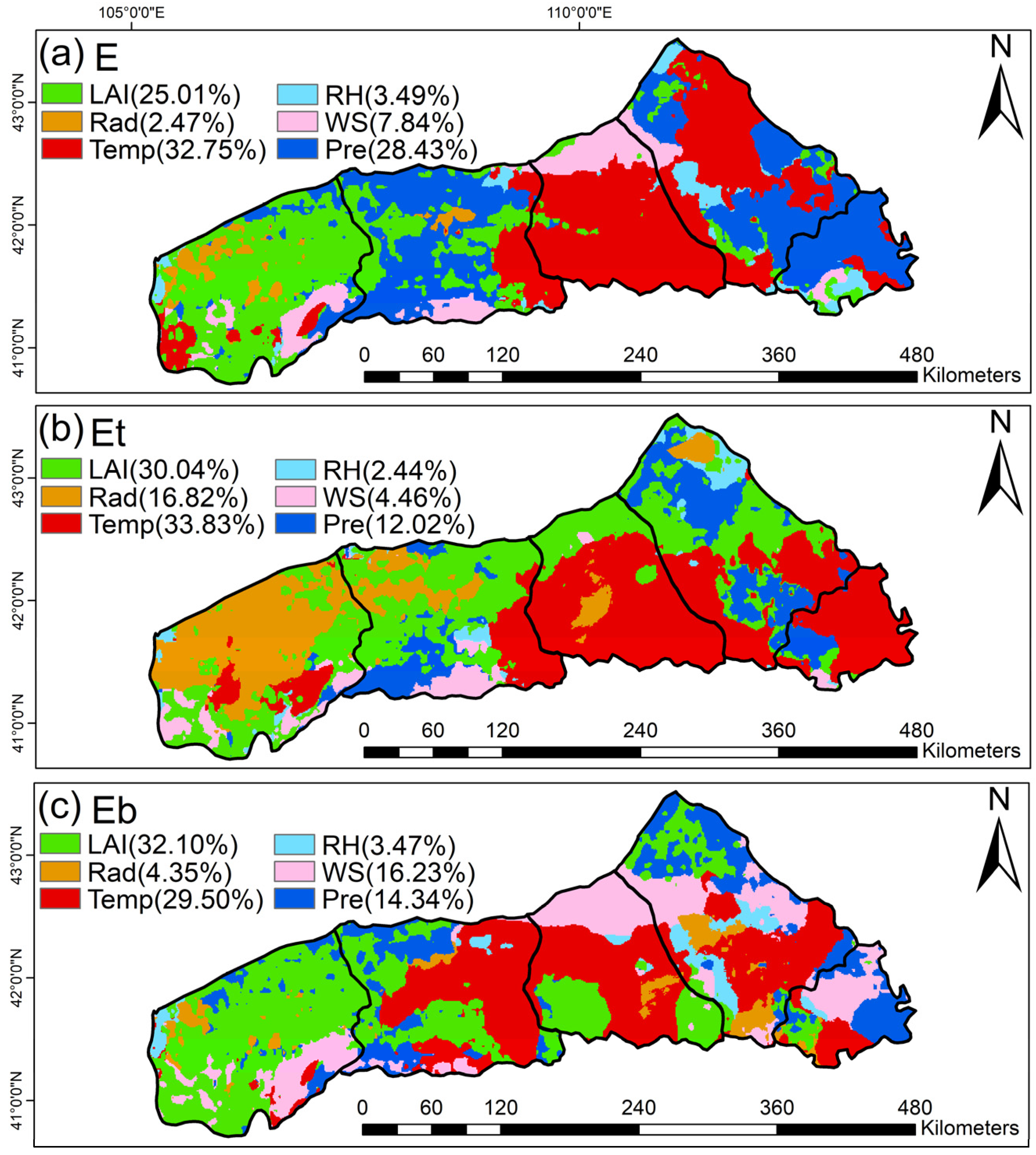

| Output Item | Factors | Direct Path Coefficients | The sum of Indirect Path Coefficients | Indirect Path Coefficients | Total Path Coefficients | |||||
|---|---|---|---|---|---|---|---|---|---|---|
| LAI | RAD | Temp | RH | WS | Pre | |||||
| E | LAI | 0.07 | 0.00 | - | - | - | - | - | - | 0.07 |
| Rad | −0.14 | 0.00 | - | - | - | - | - | - | −0.14 | |
| Temp | 0.21 | −0.19 | - | −0.09 | - | −0.10 | - | - | 0.03 | |
| RH | 0.13 | −0.01 | −0.01 | - | - | - | - | - | 0.13 | |
| WS | 0.20 | 0.13 | 0.01 | - | 0.11 | 0.00 | - | - | 0.33 | |
| Pre | 0.75 | 0.20 | 0.02 | - | - | 0.05 | 0.13 | - | 0.96 | |
| Et | LAI | 0.22 | 0.00 | - | - | - | - | - | - | 0.22 |
| Rad | −0.08 | 0.00 | - | - | - | - | - | - | −0.08 | |
| Temp | 0.17 | −0.22 | - | −0.05 | - | −0.17 | - | - | −0.05 | |
| RH | 0.22 | −0.04 | −0.04 | - | - | - | - | - | 0.18 | |
| WS | 0.36 | 0.14 | 0.05 | - | 0.09 | 0.07 | - | - | 0.50 | |
| Pre | 0.41 | 0.39 | 0.08 | - | - | 0.09 | 0.22 | - | 0.80 | |
| Eb | LAI | 0.07 | 0.00 | - | - | - | - | - | - | 0.07 |
| Rad | −0.21 | 0.00 | - | - | - | - | - | - | −0.21 | |
| Temp | 0.23 | −0.29 | - | −0.13 | - | −0.16 | - | - | −0.06 | |
| RH | 0.21 | −0.01 | −0.01 | - | - | - | - | - | 0.20 | |
| WS | 0.02 | 0.15 | 0.01 | - | 0.13 | 0.01 | - | - | 0.16 | |
| Pre | 0.84 | 0.12 | 0.02 | - | - | 0.08 | 0.01 | - | 0.96 | |
Disclaimer/Publisher’s Note: The statements, opinions and data contained in all publications are solely those of the individual author(s) and contributor(s) and not of MDPI and/or the editor(s). MDPI and/or the editor(s) disclaim responsibility for any injury to people or property resulting from any ideas, methods, instructions or products referred to in the content. |
© 2024 by the authors. Licensee MDPI, Basel, Switzerland. This article is an open access article distributed under the terms and conditions of the Creative Commons Attribution (CC BY) license (https://creativecommons.org/licenses/by/4.0/).
Share and Cite
Wang, Z.; Liu, Y.; Wang, Z.; Zhang, H.; Chen, X.; Wen, Z.; Lin, Z.; Han, P.; Xue, T. Quantifying the Spatiotemporal Changes in Evapotranspiration and Its Components Driven by Vegetation Greening and Climate Change in the Northern Foot of Yinshan Mountain. Remote Sens. 2024, 16, 357. https://doi.org/10.3390/rs16020357
Wang Z, Liu Y, Wang Z, Zhang H, Chen X, Wen Z, Lin Z, Han P, Xue T. Quantifying the Spatiotemporal Changes in Evapotranspiration and Its Components Driven by Vegetation Greening and Climate Change in the Northern Foot of Yinshan Mountain. Remote Sensing. 2024; 16(2):357. https://doi.org/10.3390/rs16020357
Chicago/Turabian StyleWang, Zijun, Yangyang Liu, Zhenqian Wang, Hong Zhang, Xu Chen, Zhongming Wen, Ziqi Lin, Peidong Han, and Tingyi Xue. 2024. "Quantifying the Spatiotemporal Changes in Evapotranspiration and Its Components Driven by Vegetation Greening and Climate Change in the Northern Foot of Yinshan Mountain" Remote Sensing 16, no. 2: 357. https://doi.org/10.3390/rs16020357
APA StyleWang, Z., Liu, Y., Wang, Z., Zhang, H., Chen, X., Wen, Z., Lin, Z., Han, P., & Xue, T. (2024). Quantifying the Spatiotemporal Changes in Evapotranspiration and Its Components Driven by Vegetation Greening and Climate Change in the Northern Foot of Yinshan Mountain. Remote Sensing, 16(2), 357. https://doi.org/10.3390/rs16020357












